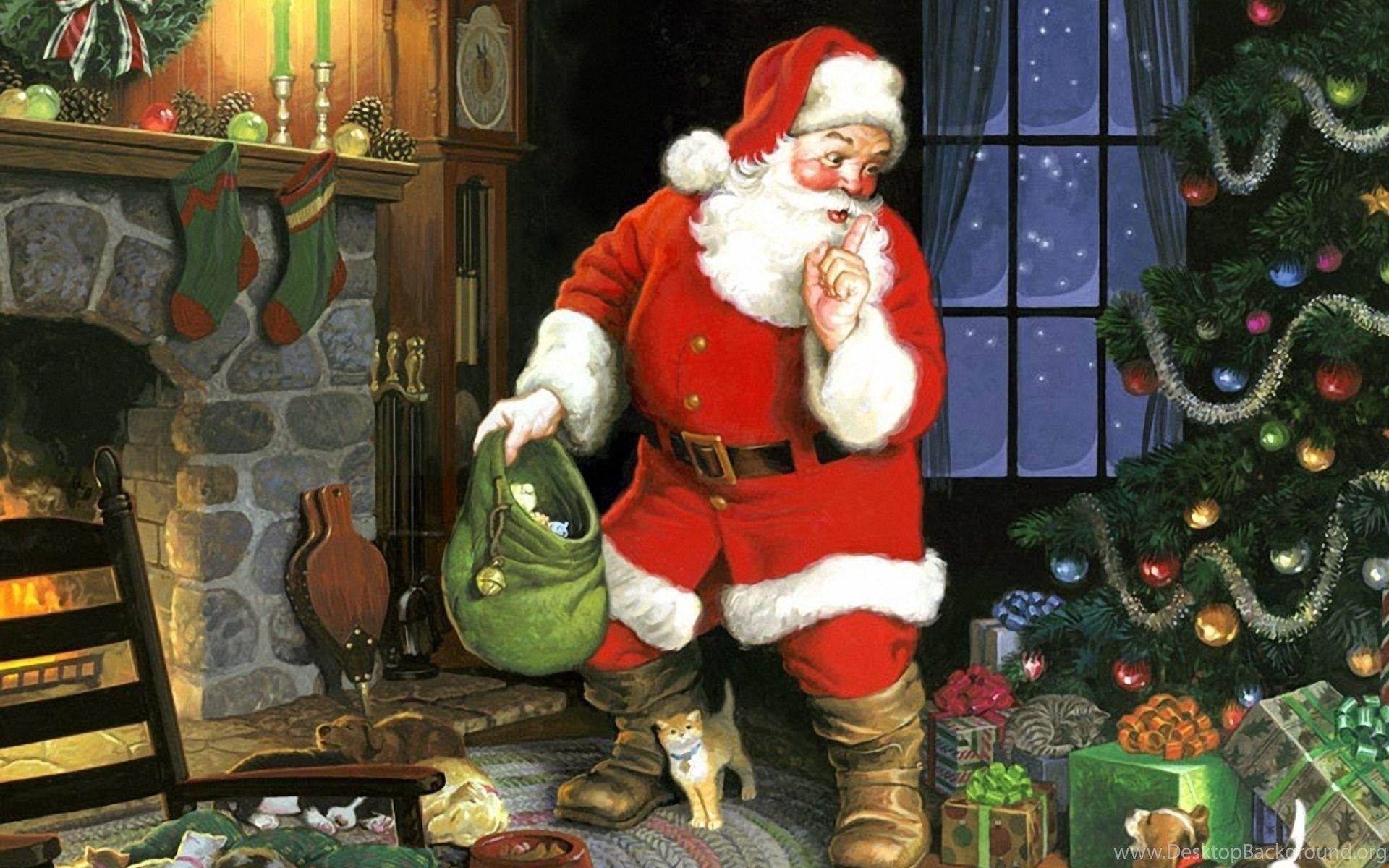Few figures are as universally recognized and beloved as Santa Claus, the jolly, red-suited giver of gifts who embodies the spirit of Christmas. Yet, the iconic image we hold in our minds today wasn't always so consistent. Before the 20th century, depictions of Santa Claus varied wildly, from gaunt figures to elfin creatures, and even some rather scary versions. It was a specific advertising campaign by a global beverage giant that played an unparalleled role in solidifying the warm, cheerful, and plump image of Santa Claus that has become firmly embedded in our collective consciousness: the Santa Claus Coca-Cola helped define.
This article delves into the fascinating history behind how Coca-Cola, through the visionary artistry of Haddon Sundblom, transformed the diverse interpretations of Saint Nicholas into the universally adored figure we celebrate every holiday season. We'll explore the origins of this iconic partnership, the subtle details that made Sundblom's Santa so endearing, and the lasting legacy of a marketing campaign that transcended mere advertising to become a cornerstone of Christmas tradition.
Table of Contents
- The Ever-Evolving Santa Before Coca-Cola
- The Birth of an Icon: Haddon Sundblom and the Coca-Cola Commission
- Sundblom's Inspiration and Artistic Vision
- The Details That Made the Difference
- Sprite Boy: Santa's New Friend in the '40s
- The Campaign's Enduring Legacy
- Debunking the Myth: Coca-Cola Did Not Create Santa
- The Global Impact of the Coca-Cola Santa
The Ever-Evolving Santa Before Coca-Cola
Before the early 20th century, the visual representation of Santa Claus was remarkably inconsistent and lacked a definitive, universally accepted form. Imagine a world where Santa could appear as a tall, gaunt man, almost ascetic in his demeanor, or perhaps as a nimble, sprightly elf, more akin to a mischievous woodland creature than a benevolent gift-giver. Indeed, historical records even reveal instances of a "scary claus," a figure designed to instill discipline and fear rather than the warmth and joy we associate with him today. This wide array of interpretations meant that while the legend of Saint Nicholas, or Sinterklaas (an abbreviation of Sint Nikolaas, the informal Dutch name for St. Nicholas, which is the root of "Santa Claus"), was prevalent, his visual identity remained fluid and open to individual interpretation across different cultures and regions.
- Feb 12 Zodiac
- Matthew Mcconaughey And Woody Harrelson
- Audrey Elizabeth Schelske
- Lord Snowdon
- Joe Jonas Kids
Adding to this visual diversity, Santa's attire was far from standardized. Prior to the influential Coca-Cola campaign, Santa had been depicted in various colors, including green, brown, blue, and even purple. There was no single, iconic red suit that dominated the popular imagination. Some early depictions were somewhat similar to the modern Santa in terms of a beard or a sack of toys, but others looked distinctly elven or, as mentioned, even somewhat demonic in their portrayal. This patchwork of visual identities meant that despite the enduring legend, there was a significant void in the collective consciousness regarding a singular, recognizable image of Santa Claus. This historical context is crucial to understanding the profound impact that one particular advertising campaign would soon have on shaping this beloved figure.
The Birth of an Icon: Haddon Sundblom and the Coca-Cola Commission
The pivotal moment that would forever alter the visual landscape of Christmas arrived in 1931. The Coca-Cola Company, seeking to boost its winter sales, which traditionally lagged behind summer figures, embarked on an ambitious advertising campaign. Their objective was to forge a strong association between their refreshing beverage and the festive spirit of the holiday season. For this monumental task, the company turned to a talented illustrator named Haddon Sundblom. Sundblom, an advertising artist with the D'Arcy agency, was commissioned to design a new Santa for Coca-Cola's Christmas advertisements, a decision that would prove to be one of the most impactful marketing moves in the history of advertising and popular culture.
Sundblom’s brief was not simply to draw another Santa, but to create a warm, happy character with distinctly human features that would resonate deeply and emotionally with the American public. The goal was to make this Santa approachable, kind, and inherently joyful, a stark contrast to some of the more austere or frightening depictions that had existed previously. The campaign featuring Sundblom’s Santa was meticulously crafted to become firmly embedded into the American consciousness, a feat it achieved with unparalleled success. So effective was his design that Sundblom would continue to illustrate Santa for The Coca-Cola Company for the next three decades, from 1931 until 1964, a remarkable testament to the enduring appeal and effectiveness of his initial vision and the iconic Santa Claus Coca-Cola brought to life.
Biography of Haddon Sundblom
Haddon Hubbard Sundblom (1899–1976) was an American artist whose name became synonymous with the modern depiction of Santa Claus. Born in Muskegon, Michigan, Sundblom was largely a self-taught artist, a testament to his innate talent and dedication. He began his career in advertising, quickly establishing himself as a prominent figure in the field due to his exceptional ability to infuse his characters with warmth, realism, and a captivating sense of life. While his iconic work for The Coca-Cola Company is undoubtedly his most famous contribution, Sundblom's artistic prowess extended to numerous other major brands, including Quaker Oats, Nabisco, and Maxwell House, demonstrating his versatility and demand as a commercial illustrator. His distinctive artistic style, characterized by its vibrant color palettes, expressive figures, and inviting compositions, made him a master of commercial illustration, capable of creating images that resonated deeply with the public. Sundblom's profound impact on American culture and the field of illustration was formally recognized in 1999 when he was posthumously inducted into the Society of Illustrators Hall of Fame, solidifying his legacy as one of the most influential illustrators of the 20th century, particularly for his role in shaping the definitive Santa Claus Coca-Cola presented to the world.
| Attribute | Detail |
|---|---|
| Full Name | Haddon Hubbard Sundblom |
| Born | June 22, 1899, Muskegon, Michigan, USA |
| Died | March 10, 1976, Chicago, Illinois, USA |
| Nationality | American |
| Occupation | Illustrator, Advertising Artist |
| Known For | Creating the iconic Coca-Cola Santa Claus, Pin-up art, Commercial illustration |
| Key Contribution | Standardizing and popularizing the modern visual depiction of Santa Claus worldwide |
Sundblom's Inspiration and Artistic Vision
To craft the definitive Santa Claus for Coca-Cola, Haddon Sundblom didn't conjure the character out of thin air. Instead, he meticulously drew inspiration from existing literary works, providing his artistic vision with a solid foundation. His primary source of inspiration was Clement Clark Moore’s seminal 1822 poem, “A Visit from St. Nicholas,” more commonly known as “‘Twas the Night Before Christmas.” This cherished poem offered a remarkably vivid and detailed textual description of Santa, portraying him as a "jolly old elf" with a "broad face and a little round belly, that shook when he laughed, like a bowl full of jelly," and a nose "like a cherry." Sundblom painstakingly translated these evocative words into visual form, giving Santa a plump, cheerful, and genuinely joyful demeanor that perfectly captured the spirit of the poem.
Sundblom’s artistic choices were deliberate and strategic, aimed at creating a character that exuded warmth, benevolence, and an undeniable sense of approachability. His Santa was designed to be kind, comforting, and inherently tied to the happiness and wonder of the holiday season, standing in stark contrast to the more austere or even frightening depictions that had previously existed. The immediate and profound success of his vision quickly established his Santa as the standard, setting a new benchmark for how the festive figure would be perceived. This artistic synthesis of literary description and commercial purpose resulted in a Santa Claus that resonated deeply with the public, becoming an instant icon that would endure for generations.
The Details That Made the Difference
What made Sundblom’s Santa truly iconic was not just his overall jolly appearance, but the myriad of specific, humanizing details he incorporated into each painting. These nuances, often subtle, contributed significantly to the character's profound appeal and the lasting impact of the Santa Claus Coca-Cola presented. For his initial and most influential portrayals, Sundblom reportedly used a retired salesman named Lou Prentiss as his primary model. Prentiss's naturally cheerful disposition and robust physique perfectly embodied the benevolent Santa Sundblom envisioned, lending an authentic warmth to the illustrations.
As years passed and Prentiss was no longer available, Sundblom often resorted to painting Santa by looking in a mirror, using himself as a model. This personal approach sometimes led to charming, unintentional quirks that only served to make Santa more relatable. For instance, in one famous instance, Santa’s large belt was depicted backwards, a detail that many speculate occurred because Sundblom was painting his own reflection. In another memorable painting, Santa Claus appeared without a wedding ring, a seemingly minor oversight that prompted a flurry of letters from concerned fans, genuinely asking about Mrs. Claus! These minor "imperfections" paradoxically made Santa feel more human, fostering a deeper, more personal connection with the audience. Even the animals in his paintings were given unique backstories: the dog featured in Sundblom’s 1964 Santa Claus painting, his final one, was actually a grey poodle belonging to his neighborhood florist. However, Sundblom, with his keen eye for visual impact, wanted the dog to stand out vividly in the festive holiday scene, so he painted the animal with striking black fur. Such meticulous attention to detail, extending even to background elements, underscored Sundblom's dedication to creating a rich, believable, and utterly endearing world for his Santa, solidifying the image of the Santa Claus Coca-Cola made famous.
Sprite Boy: Santa's New Friend in the '40s
As the Coca-Cola Santa Claus campaign gained undeniable momentum and firmly established itself as a beloved holiday staple, the advertising narrative continued to evolve and expand. In 1942, The Coca-Cola Company introduced a new character to its festive advertisements: Sprite Boy. This playful, diminutive character was designed to appear alongside Santa Claus in Coca-Cola advertising throughout the 1940s and 1
- December 27 Zodiac
- Middle Names For Girls
- Reggie Bush Heisman
- Kylie Jenner Bikini
- How Old Was Carrie Underwood When She Won American Idol


